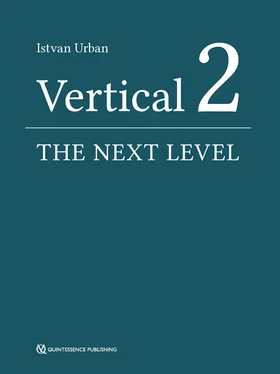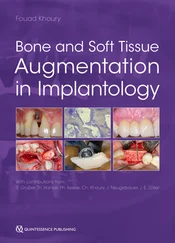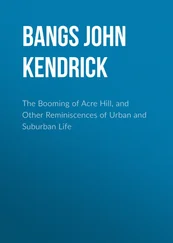2. Urban I, Farkasdi S, Munoz F, VIgnoletti F, Varga G. Dense versus perforated PTFE membranes using a xenogenic graft material [in progress].
3. Urban I. Dense versus a novel form of stable collagen membrane using a xenogenic graft material [in progress].
4. Urban I, Farkasdi S, Bosshard D, Owusu S, Wikesjo U. Perforated PTFE membranes using a microdose of BMP-2 in conjunction with a xenogenic graft material [in progress].
2
Scientific evidence of vertical bone augmentation utilizing a titanium-reinforced polytetrafluoroethylene mesh
Introduction
This chapter examines how a dense polytetrafluoroethylene (d-PTFE) mesh was investigated in the author’s clinical practice. The primary study objectives were:
1. To evaluate the amount of bone height gain in millimeters and as a percentage of the baseline deficiency as a result of vertical bone augmentation (VBA) using a titanium-reinforced PTFE mesh (RPM) with mixed autogenous and anorganic bovine bone mineral (ABBM) particulate grafts.
2. To examine the influence of defect location, baseline deficiency extent, and membrane exposure on augmentation height.
3. To report the incidence of surgical and postsurgical complications associated with this treatment.
Fifty-seven consecutive patients who had been treated using RPM with mixed autogenous and ABBM particulate grafts for pre-implantation VBA between August 2016 and June 2019 were included for analysis. All patients were treated at one private practice (Urban Regeneration Institute, Budapest, Hungary). All VBA procedures were performed by the same experienced practitioner (IU). Implant placement and subsequent prosthetic treatments were performed by the author (IU) or other private practitioners. Our study was approved by the Institutional Review Board for Human Studies (118/2020-SZTE). Strengthening the Reporting of Observational Studies in Epidemiology (STROBE) guidelines were followed during the preparation of this chapter.
Inclusion and exclusion criteria
The patients included in this study had insufficient vertical bone, which precluded stable dental implant placement or would result in poor crown-to-implant ratios or esthetic compromise. Participants were required to have sound physical health and good oral hygiene prior to treatment (Plaque Index of < 10%). 1
Patients were excluded if any of the following criteria were present:
1. Bone augmentation procedures not using RPM.
2. Heavy smokers (> 10 cigarettes/day).
3. History of local radiation therapy within the previous 5 years.
4. Uncontrolled diabetes mellitus.
5. Alcoholism or chronic drug abuse.
6. Any uncontrolled medical conditions.
Potential risks and benefits of the VBA procedure were reviewed presurgically with all enrolled patients. Written consent was obtained from all patients prior to surgery. All participants received prophylactic systemic antibiotic coverage with 500 mg amoxicillin three times a day or, in the case of penicillin allergy, 150 mg clindamycin four times a day 24 hours prior to surgery.
A midcrestal incision was made in the keratinized mucosa of the edentulous site to be augmented, and sulcular incisions were made around the adjacent teeth. Periosteal elevators were used to raise full-thickness mucoperiosteal flaps extending at least 5 mm apical to the alveolar crest; particular care was given to sites with thin mucosa or minimal to no keratinized tissue to avoid flap perforation. To enhance access, two vertical releasing incisions were made at least one tooth away from the surgical site. The depth and location of the vertical releasing incisions as well as the technique used for flap management depended on the depth of the vestibule and the extent of the existing defect. 2For mandibular cases, lingual flaps were elevated to the mylohyoid muscle attachment, which was then bluntly separated. 3
Each recipient site was decorticated using a small round bur to increase blood supply to the recipient bed. A particulate autograft was harvested with a bone scraper from intraoral sites adjacent to the defect (Osteogenics Biomedical, Lubbock, TX, USA). The amount of bone harvested was based on the size of the graft needed. Autogenous bone particulate was mixed with ABBM (Bio-Oss; Geistlich Pharma, Wolhusen, Switzerland) in a 1:1 ratio and positioned on the residual ridge to mimic the desired bone morphology.
The area to be covered by mesh was estimated using a University of North Carolina-15 (UNC-15 (probe, and an appropriately sized RPM was selected, trimmed, and placed to completely cover the graft and at least 2 mm of adjacent native bone. The mesh was stabilized on the lingual/palatal sides using titanium pins (Master-Pin; Meisinger, Neuss, Germany) or screws (Pro-fix; Osteogenics Biomedical). 2The membrane was then covered with a native collagen membrane in all cases (Bio-Gide; Geistlich Pharma).
Periosteal releasing incisions were carefully made to advance buccal flaps. In premolar sites, the mental nerve was protected, particularly in cases with severe atrophy that demanded more apically extending vertical incisions. Lingual flaps were advanced based on the location of the mylohyoid muscle attachment and were handled according to three previously described zones of interest. 3
Double-layered suturing was employed to create intimate tissue adaptation and prevent membrane exposure. In this technique, horizontal mattress sutures (GORE-TEX CV-5 Suture; W. L. Gore & Associates, Flagstaff, AZ, USA) were placed 4 to 5 mm from the incision line. Then, single interrupted sutures were used to secure all flap edges. The sutures were left undisturbed for at least 2 to 3 weeks. The surgical site was allowed to heal for at least 6 months. At re-entry, limited mucoperiosteal flaps were elevated to remove the RPM and titanium pins and/or screws and to perform implant placement.
A postoperative regimen of amoxicillin 500 mg three times a day for 7 days or, in the case of penicillin allergy, 150 mg clindamycin four times a day for 6 days was prescribed. A nonsteroidal anti-inflammatory drug (50 mg diclofenac potassium three times a day or ibuprofen 200 mg four times a day (was prescribed for 1 week following the surgery. All patients were evaluated at 1, 2 or 3, and 4 weeks following surgery. Intraoperative and postoperative complications such as membrane exposure, intraoperative bleeding, and graft infection were recorded.
Patient information including gender, age at the time of surgical treatment, and self-reported cigarette consumption were recorded. Intraoperatively, the extent of the baseline vertical deficiency was measured by one clinician (IU) in millimeters from the residual ridge crest to one reference line using a UNC-15 probe. One of two reference lines was used to ensure consistent vertical measurements and to serve as ideal heights: 1) an imaginary line connecting the interproximal bone height between adjacent teeth; or 2) in the case of distal edentulism, an imaginary line connecting the proximal tooth bone height to the projected non-resorbed alveolar crest of the edentulous area. The vertical bone gain was evaluated at the time of implant placement (re-entry) and measured in the same way as described above. The horizontal distance between the site of measurement and the root surface/non-resorbed alveolar crest of the nearest tooth was recorded to guarantee reproducible measurements in the mesiodistal direction.
‘Absolute gain’ was defined as the amount of bone gained in millimeters regardless of baseline vertical deficiency. ‘Relative gain’ was defined as the percentage of the vertical deficiency that was resolved relative to the ideal height.
Читать дальше












